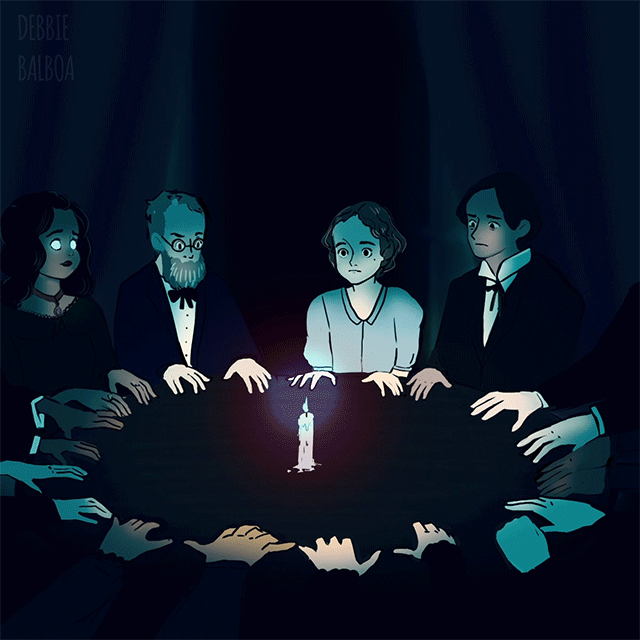
A Séance is a sitting organized for the purpose of receiving spirit communications or paranormal manifestations via a Medium.
Séances are conducted in many paranormal investigations of haunted places in order to produce evidence of Haunting, or to obtain information about Ghosts thought to be present. References to Séance communications date back as far as the writings of Porphyry in the 3rd century C.E. In 1659 Reverend Meric Casaubon wrote A True and Faithful Relation of What Passed Between Dr. Dee and Some Spirits, the first recorded Séance. Not much else on such spirit meetings appeared until the meteoric rise of the Fox Sisters in the mid-1800s. Séances were popular during the rise of Spiritualism and continue to be conducted in modern times. Early spiritualist Séances were dramatic and theatrical, taking place in darkened parlours around circular tables and featuring physical mediumistic feats. Most modern Séances involve mental Mediumship and are more informal.
Séances are most often held in the home of either the medium or one of the sitters, but they can take place anywhere two or more people gather for such purpose. General observances are followed to help ensure success. Participants should be nearly equally divided by gender. Younger sitters often get better results. Sitters who are worried about the proceedings or are overly skeptical tend to depress results. A circular arrangement of chairs around a table seems to work best, with no more than eight sitters. Hands are placed flat on the table, fingers touching, or sometimes clasped. Several mediums, most notably the Davenport Brothers, conducted Séances for audiences numbering over a thousand.
Strangers should be admitted to the Séance circle carefully, introduced only after at least six sittings have been held with the same persons. No more than two or three Séances should be conducted weekly, and each should last no more than two hours unless the spirits ask for an extension. Mediums must guard against extreme swings of emotion and never take stimulants. Unwritten codes of conduct forbid sitters to grab the medium in case such a sudden jarring could jeopardize the medium’s return to consciousness, causing illness or perhaps even death.
Mediums consider music and conversation to be vital to the success of the Séance. Most sittings open with hymns and prayers—in many cases, the Lord’s Prayer— and include songs and prayers throughout the Séance. William Stainton Moses found that music harmonizes and soothes the situation; critics, however, believe music covers a multitude of fraudulent noises. Conversation masks noise, too, but also breaks the fear and tension created by spirit manifestations.
The furnishings of the Séance room, and its location, set the tone for the sitting. Places steeped in colourful history, such as castles, catacombs, country houses and old churches, make propitious Séance locales. The furniture should be simple, preferably wood, and should not be ornamented with cushions or hangings. Physical mediums once included a so-called CABINET, a kind of enclosure to attract spiritual energy. This was a piece of furniture, like an armoire, but most often it was nothing more than a corner of the room hung with black curtains. The medium went inside the cabinet for manifestations or sat outside. Modern-day mediums, most of whom are mental, seldom use such props.
Lighting, or lack of it, characterized most early Séances. Mediums needed darkness to initiate spirit manifestation— critics would claim to perpetrate fraud—using either moonlight or red incandescent light. D.D. Home often worked in full light, however, and many mental mediums do also.
In the days of physical Mediumship, sitters often recognized the arrival of spirits by a rush of cool air in the room, following by Rapping or strange lights. Mental mediums may enter a trance, begin Automatic Writing or merely announce a spirit’s presence.
Not every Séance is successful, and sitters should not expect particular results. First-time sitters may be disappointed, and some participants may see phenomena others miss.
SEE ALSO:
- Channeling
- Mediumship
FURTHER READING:
- Chaney, Rev. Robert G. Mediums and the Development of Mediumship. Freeport, N.Y.: Books for Libraries Press, 1972.
- Fodor, Nandor. An Encyclopaedia of Psychic Science. Secaucus, N.J.: The Citadel Press, 1966. First published 1933.
- Pearsall, Ronald. The Table-Rappers. New York: St. Martin’s Press, 1973.
- Somerlott, Robert. “Here, Mr. Splitfoot”: An Informal Exploration into Modern Occultism. New York: The Viking Press, 1971.
SOURCE:
The Encyclopedia of Ghosts and Spirits– Written by Rosemary Ellen Guiley – September 1, 2007
